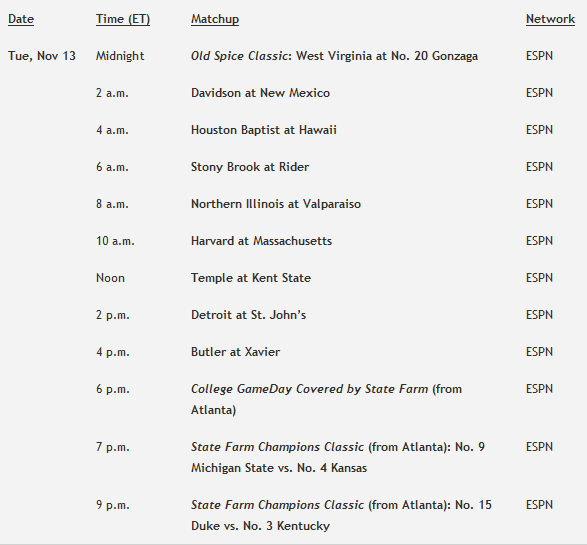Posted by rtmsf on September 25th, 2013

- Yesterday we mentioned that SI.com‘s Andy Glockner was brewing up a firestorm with his series of articles ranking the top 20 current programs in college basketball. Such an endeavor has two verifiable truths: first, everyone loves lists; second, everyone loves to rip lists. With that in mind (and he’s well aware of those truths), his honorable mentions came out Monday, followed by his rankings of programs from #16 to #20 on Tuesday. In order, let’s welcome Gonzaga, Illinois, Michigan, Georgetown and Texas to the top 20. Of this group, we’re having the most trouble with the Illinois pick at #19. The Illini had a renaissance season under the tutelage of new head coach John Groce last year, but spent most of the previous five years struggling to regain its national relevance of the early-to-mid 2000s. We realize of course that Glockner is using historical and other qualitative metrics to make these determinations, but we probably would have had Pittsburgh, Marquette, Xavier and several others ahead of the Illini. Still, that’s nitpicky. What will really make or break this list will be how Glockner handles the top five (and the fans of the four runners-up will let him know it!). We’re excited to see the next group released later today.
- As more and more people marry themselves to the idea that college football and basketball players are being exploited by their schools and the NCAA, we’ll continue to see analyses like one from Business Insider published on Tuesday. Their methodology for determining the fair market value of players at the top 25 revenue-producing football schools is quite simple, probably overly simple — just multiply football revenue by 47 percent (per the NFL’s collective bargaining agreement with its players), then divide by the number of scholarships (85). What BI found mimics the numbers we’ve seen elsewhere — at the richest athletic schools such as Texas, Alabama and Michigan, college football players are worth roughly a half-million dollars each annually in value. The same analysis is also easy enough to do for college basketball players. Louisville‘s hoops revenue of $42.4 million in 2012 is divided in half given the NBA’s rough 50/50 split with the players, leaving $21.2 million to be split 13 ways. The result: a Cardinals’ basketball player is worth $1.63 million to the university (if you buy into this methodology). This is the mistake that many of these gridiron-centric analyses don’t realize — while it’s definitely true that football provides more aggregate revenue to the schools, the players in college basketball are individually much more valuable. If you want to make the point most strongly, which is the better headline? Texas football players are worth a half-million each; or Louisville basketball players are worth three times that much?
- While on the subject of football powers, the NCAA announced yesterday that Penn State would regain some of the football scholarships it lost as a result of the Jerry Sandusky sexual abuse scandal. In announcing the removal of those sanctions, the NCAA recognized that the school had made great efforts to change its culture of abuse but NCAA president Mark Emmert made it clear that other schools shouldn’t expect a reduction in their own penalties. That’s too bad, writes The Dagger‘s Jeff Eisenberg, who outlines four major recent (and fixable) misfires by the NCAA, two of which were focused on men’s basketball. The most well-known example, of course, was the NCAA’s “strict liability” punishment on Memphis for playing Derrick Rose in the 2007-08 season, even though the NCAA Clearinghouse had deemed him eligible to play before that season. The other is far less recognizable, involving the NCAA’s decision to rule that Old Dominion’s Donte Hill was ineligible for his senior season because he played eight minutes in a closed-door preseason scrimmage against Clemson back in 2010. We’re quite sure that we could probably come up with a dozen more of these if we spent the time on it, but Eisenberg’s list is a good place to start. It wouldn’t hurt the NCAA to consider more reductions (or commutation) of sentences based on additional facts, precedents and behaviors.
- What’s a Final Four appearance worth to an MVC school like Wichita State? We’ll have to wait for the Business Insider analysis on that one, but it’s at least worth around $600,000 to its head coach, Gregg Marshall. The university announced his new salary on Tuesday, with a base of $1.6 million that kicks in this November and another raise to $1.75 million that begins next April. The long-underrated head coach will move into the top 25 or so highest-paid college basketball coaches as a result of this raise, which is a substantial financial commitment for a school living outside the Power Six or Seven hoops leagues. But Final Four appearances at schools like Wichita State tend to result in ironclad job security.
- Believe it or not, but with the new practice rules in effect this season, schools will actually begin suiting up for real, live, full-on practices this Friday. As in 48 hours from now. One of the players who will definitely be there to play post-practice games of HORSE with his teammates is Ole Miss’ Marshall Henderson. As reported by Gary Parrish at CBSSports.com, Andy Kennedy expects the all-SEC shooting guard to be on the floor Friday. The controversial shooting guard reportedly failed multiple drug tests and spent much of the offseason “suspended” from the team, whatever that means, but let’s be honest with ourselves here. There aren’t all that many name-brand players who pass through Oxford, Mississippi — especially in roundball — so there was not much of a question as to whether Henderson would suit up this year.
| morning 5, Regular Features
| Tagged: andy glockner, contract extensions, derrick rose, gregg marshall, illinois, marshall henderson, memphis, ncaa violations, ole miss, penn st, suspensions, top 20 programs, wichita st
Share this story











































